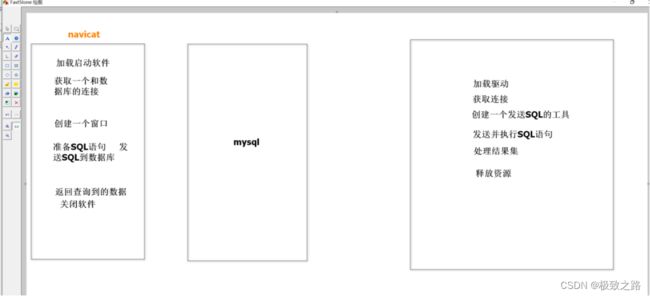idea中jdbc连接数据库
idea连接数据库
- 1.引入jar包
- 二、jdbc六步
- 三、JDBC的ORM(对象关系映射)
-
- 1.entity实体类及对应的表
- 2.以.properties结尾的配置文件
- 3.utils包
- 4.dao包及Impl包
- 5.测试类
1.引入jar包
在项目名下创建一个名为lib的包,将mysql-connector-java-8.0.23.jar放进去。
在对准这个jar包,点击右键,add as library(作为库添加)。

二、jdbc六步
public class InsertPerson {
public static void main(String[] args) throws SQLException,ClassNotFoundException {
//1.加载驱动
Class.forName("com.mysql.cj.jdbc.Driver");
//2.获取连接
String url="jdbc:mysql://localhost:3306/lvning?useUnicode=true&characterEncoding=UTF-8&useSSL=false&serverTimezone=Asia/Shanghai";
String username="root";
String passwd="123456";
Connection conn = DriverManager.getConnection(url, username,passwd);
// 3.获取一个发送sql的工具
String sql="insert into t_person values(1,'岳不群',45,'男','1774322132','华山')";
PreparedStatement pstm = conn.prepareStatement(sql);
//4.发生并执行sql
int update = pstm.executeUpdate();
//5.处理结果集
//6.释放资源
pstm.close();
conn.close();
}
}
其中:
获取连接:String
url=“jdbc:所使用的是哪个数据库(mysql或其他)/localhost:端口号/数据库名?useUnicode=true&characterEncoding=UTF-8&useSSL=false&serverTimezone=Asia/Shanghai”;
三、JDBC的ORM(对象关系映射)
1.entity实体类及对应的表
public class Person {
private Integer id;
private String name;
private Integer age;
private String sex;
private String mobile;
private String address;
public Person(Integer id, String name, Integer age, String sex, String mobile, String address) {
this.id = id;
this.name = name;
this.age = age;
this.sex = sex;
this.mobile = mobile;
this.address = address;
}
public Person() {
}
@Override
public String toString() {
return "Person{" +
"id=" + id +
", name='" + name + '\'' +
", age=" + age +
", sex='" + sex + '\'' +
", mobile='" + mobile + '\'' +
", address='" + address + '\'' +
'}';
}
public Integer getId() {
return id;
}
public void setId(Integer id) {
this.id = id;
}
public String getName() {
return name;
}
public void setName(String name) {
this.name = name;
}
public Integer getAge() {
return age;
}
public void setAge(Integer age) {
this.age = age;
}
public String getSex() {
return sex;
}
public void setSex(String sex) {
this.sex = sex;
}
public String getMobile() {
return mobile;
}
public void setMobile(String mobile) {
this.mobile = mobile;
}
public String getAddress() {
return address;
}
public void setAddress(String address) {
this.address = address;
}
}
表结构:
DROP TABLE IF EXISTS `t_person`;
CREATE TABLE `t_person` (
`person_id` int(11) NOT NULL AUTO_INCREMENT,
`person_name` varchar(20) CHARACTER SET utf8 COLLATE utf8_general_ci NULL DEFAULT NULL,
`age` tinyint(4) NULL DEFAULT NULL,
`sex` enum('男','女','其他') CHARACTER SET utf8 COLLATE utf8_general_ci NULL DEFAULT NULL,
`mobile` varchar(20) CHARACTER SET utf8 COLLATE utf8_general_ci NULL DEFAULT NULL,
`address` varchar(200) CHARACTER SET utf8 COLLATE utf8_general_ci NULL DEFAULT NULL,
PRIMARY KEY (`person_id`) USING BTREE
) ENGINE = InnoDB AUTO_INCREMENT = 14 CHARACTER SET = utf8 COLLATE = utf8_general_ci ROW_FORMAT = Dynamic;
SET FOREIGN_KEY_CHECKS = 1;
2.以.properties结尾的配置文件
在src下创建jdbc.properties文件。
将驱动driver,url,username及passwd都写在配置文件里。
driver = com.mysql.cj.jdbc.Driver
url = jdbc:mysql://localhost:3306/lvning?useUnicode=true&characterEncoding=UTF-8&useSSL=false&serverTimezone=Asia/Shanghai
username = root
password = 123456
3.utils包
public class JDBCutils
private static ThreadLocal<Connection> tl = new ThreadLocal<Connection>();
private static Properties prop = new Properties();
static {
try {
//通过流读取jdbc.properties文件中内容
//通过类对象的getResourceAsStream()获取配置文件输入流
// InputStream in = new FileInputStream("./src/jdbc.properties");
// /表示com超级父包所在的目录
InputStream in = JDBCUtils.class.getResourceAsStream("/jdbc.properties");
//自动的使用输入流读取配置文件,并将键值对数据保存到本身
prop.load(in);
in.close();
String driverClassName = prop.getProperty("driver");
Class.forName(driverClassName);
}catch(Exception e) {
e.printStackTrace();
throw new RuntimeException(e);
}
}
//抽取JDBC前2步
public static Connection getConnection() {
//从当前线程空间中获取conn
Connection conn = tl.get();
//如果获取不到,说明是第1次获取连接,则从数据库中获取,然后保存到线程中
if(conn == null) {
try {
String url = prop.getProperty("url");
String user = prop.getProperty("username");
String password = prop.getProperty("password");
conn = DriverManager.getConnection(url, user, password);
tl.set(conn);
}catch(Exception e) {
e.printStackTrace();
throw new RuntimeException(e);
}
}
//conn不为空,说明不是第1次,则直接返回从线程对象中获取的连接
return conn;
}
//抽取JDBC最后1步
public static void close(Connection conn,ResultSet rs,PreparedStatement pstm) {
if(rs != null) {
try {
rs.close();
} catch (SQLException e) {
e.printStackTrace();
}
}
if(pstm != null) {
try {
pstm.close();
} catch (SQLException e) {
e.printStackTrace();
}
}
if(conn != null) {
try {
conn.close();
} catch (SQLException e) {
e.printStackTrace();
}
}
}
public static void main(String[] args) {
Connection connection = getConnection();
System.out.println(connection);
}
}
4.dao包及Impl包
public interface PersonDao {
int insertPerson(Person p);
int deletePersonById(Integer id);
int updatePerson(Person p);
Person selectPersonById(Integer id);
List<Person> selectAllPerson();
}
实现类:
public class PersonDaoImpl implements PersonDao {
//
@Override
public int insertPerson(Person p) {
Connection conn = JDBCutils.getConnection();
String sql="insert into t_person values (null ,?,?,?,?,?)";
PreparedStatement pstm = null;
int update = 0;
try {
pstm = conn.prepareStatement(sql);
pstm.setString(1,p.getName());
pstm.setInt(2,p.getAge());
pstm.setString(3,p.getSex());
pstm.setString(4,p.getMobile());
pstm.setString(5,p.getAddress());
update = pstm.executeUpdate();
} catch (SQLException e) {
e.printStackTrace();
}
JDBCutils.close(conn,null,pstm);
return update;
}
@Override
public int deletePersonById(Integer id) {
Connection conn = JDBCutils.getConnection();
PreparedStatement pstm = null;
int update=0;
try {
String sql="delete from t_person where person_id=?";
pstm = conn.prepareStatement(sql);
pstm.setInt(1,id);
update = pstm.executeUpdate();
} catch (SQLException e) {
e.printStackTrace();
}
JDBCutils.close(conn,null,pstm);
return update;
}
@Override
public int updatePerson(Person p) {
Connection conn = JDBCutils.getConnection();
String sql="update t_person set person_name=? ,age=? where person_id=?";
PreparedStatement pstm = null;
int update = 0;
try {
pstm = conn.prepareStatement(sql);
pstm.setString(1,p.getName());
pstm.setInt(2,p.getAge());
pstm.setInt(3,p.getId());
update = pstm.executeUpdate();
} catch (SQLException e) {
e.printStackTrace();
}
JDBCutils.close(conn,null,pstm);
return update;
}
@Override
public Person selectPersonById(Integer id) {
Connection conn = JDBCutils.getConnection();
String sql="select * from t_person where person_id=?";
PreparedStatement pstm = null;
Person person= null;
try {
pstm = conn.prepareStatement(sql);
pstm.setInt(1,id);
ResultSet rs = pstm.executeQuery();
person = null;
while (rs.next()) {
int id1 = rs.getInt(1);
String name = rs.getString(2);
int age = rs.getInt(3);
String sex = rs.getString(4);
String mobile = rs.getString(5);
String address = rs.getString(6);
person = new Person(id1, name, age, sex, mobile, address);
}
} catch (SQLException e) {
e.printStackTrace();
}
JDBCutils.close(conn,null,pstm);
return person;
}
@Override
public List<Person> selectAllPerson() {
Connection conn = JDBCutils.getConnection();
String sql="select * from t_person";
List<Person> persons = new Vector<>();
Person person=null;
ResultSet rs=null;
PreparedStatement pstm=null;
try {
pstm = conn.prepareStatement(sql);
rs = pstm.executeQuery();
while (rs.next()){
int id = rs.getInt(1);
String name = rs.getString(2);
int age = rs.getInt(3);
String sex = rs.getString(4);
String mobile = rs.getString(5);
String address = rs.getString(6);
person = new Person(id, name, age, sex, mobile, address);
persons.add(person);
}
} catch (SQLException e) {
e.printStackTrace();
}
JDBCutils.close(conn,rs,pstm);
return persons;
}
}
5.测试类
public class Test {
public static void main(String[] args) {
PersonDaoImpl personDao = new PersonDaoImpl();
// int i = personDao.deletePersonById(3);
// System.out.println(i);
// List persons = personDao.selectAllPerson();
// System.out.println(persons);
// Person person = new Person(null, "江宁", 18, "男", "123xxxxxx", "华山");
// Person person = new Person(5, "任我行", 30, "男", "123xxxxxx", "未知");
// int i = personDao.insertPerson(person);
// System.out.println(i);
//
// int i = personDao.updatePerson(person);
// System.out.println(i);
Person person = personDao.selectPersonById(1);
System.out.println(person);
}
}


